It’s because I always end up typing the wrong message in the wrong chat window. So far, I haven’t done anything as embarrassing as the ChaCha guide below, but I’m not going to tempt fate…

Screen capture courtesy of Miss Fipi Lele.
It’s because I always end up typing the wrong message in the wrong chat window. So far, I haven’t done anything as embarrassing as the ChaCha guide below, but I’m not going to tempt fate…

Screen capture courtesy of Miss Fipi Lele.

At the end of 1992, when the marriages of her children, Prince Charles, Prince Andrew and Princess Anne all dissolved and Windsor Castle caught fire, Queen Elizabeth II alluded to the title of John Dryden’s poem Annus Mirabilis (“Year of Miracles”) and referred to the year as an annus horribilis (“horrible year”).
As H.R.H. the Queen of England riffed on Dryden’s coinage, so shall I riff upon hers. If I had to summarize the year between 2008 in a quick soundbite, I would use the pseudo-Latin coinage Annus Assrocketis, as in “Year of Assrockets”.
A little bit over a year ago, I wrote an article titled Assrockets and Opportunities explaining why I was leaving my job as Tucows’ Technical Evangelist, a relatively safe, secure and cushy job – one that its CEO Elliot Noss said “fit me like a glove” — for a startup in the rather iffy social software space.
I had been feeling a little bit restless for a little while, but that restlessness alone wasn’t enough to make me take the leap. Strangely enough, it took a video of a guy sticking a bottle rocket up his butt and an observation made by Charles Follymacher in the blog The War on Folly. Assrockets and Opportunities summarized how the video and Follymacher’s blog entry inspired me to change jobs.
As a quick refresher, here’s the video. Be advised that it may not be safe to view at your workplace, as it shows a young man’s bare bottom and a bottle rocket stick being inserted into said bottom. It also has a lot of crude vernacular that young men are wont to use. That being said, I still think it’s one of the funniest internet home videos of all time and it still makes me laugh out loud, even after hundreds of viewings:
Still the funniest video of all time.
In response to this video, Follymacher, a person of colour (I myself prefer the term “force of darkness” – it has a little more oomph) wrote a hilarious and insightful observation titled why White people rule this age. The relevant excerpts appear below:
…I’m once again reminded why White people rule the globe. It’s not a new idea, just feeling compelled to state it once more, this time without feeling: they run the world because they have a much (much) higher percentage of folk who will do absolutely *anything.* any bloody, assinine [sic] thing at all. if you can name it, guaranteed it will be tried, if it hasn’t been already.
it is out of these absolutely stark, raving, barking mad experiments that new discoveries are made, which in turn lead to a fresh new batch of shit to fuck with. new answers urge new questions and all that, right?
…
us colored peoples of the world tend to leave well enough alone a lot more, not much for forcing Mother Nature’s hand. our ancient sciences are lost. that’s our bad. who knew? we didn’t ask. and now it may be too late to churn up that kind of insatiable hunger for knowledge.
a lot of White folk die off in these quests to discover and experience the unknowns, large or wtf. but some small percentage do manage to live to tell the tale and, wherever possible, wreak [sic] the profits.
I read the article in mid-October of last year and decided that it was high time I stuck a rocket up my ass, at least in the figurative sense. I put out a few feelers into the local tech job market.
Soon after that, I ran across an announcement of an open position at a startup looking for Ruby on Rails developers. The salary offered was a good deal better than my then-current one, and the opportunity to get back to writing code was very tempting. In five weeks, I went from replying to the offer to my first day on the job, the Monday after American Thanksgiving 2007.
Since that time, I have had three jobs.
The startup I left Tucows to join – I don’t even like mentioning their name; you can look it up in this blog’s archives if you really must know – was building a Facebook-like web app for fraternities and sororities (“So you’re telling me that it’s like Facebook, but for students,” Cory Doctorow would say much later).
It might’ve stood a chance if it had these three missing ingredients:
Truth be told, having missing ingredient number 3 might’ve given us missing ingredients number 1 and 2.

Click the montage to see the Flickr photoset.
Perhaps I’ll write about it at length someday, but for now a quick summary of what happened to this startup will have to suffice. They burned through money irresponsibly in many ways, including:

The ice sculpture at the office-warming party.
Alarmed at the company’s burn rate and lack of income, the source of the startup’s funding threatened to cut off the money. We were then informed by the CEO that unless we accelerated the schedule unreasonably, we’d all have to take a 20% pay cut. He went on vacation to Hawaii with his girlfriend a couple of days after that because he always went on vacation to Hawaii with his girlfriend at that time of year, crisis at his own company be damned.
While he was away, the entire senior developer team, of which I was part, started circulating their resumes and putting out the word that they were looking for new jobs. Within six weeks, the senior team had left the company. Within six months, the company had all but vanished. The website for the software no longer works, and the website for the company is now a single page showing the startup logo and nothing more.
My job at the startup, which had gone from dream to nightmare, lasted three months and a few days. The name of the startup still gets mentioned from time to time at local geek gatherings, sometimes as a cautionary tale, sometimes as a joke.
While searching around for jobs, I noticed that b5media was looking for a technical project manager. “b5”, as they’re often called, is a local startup success story, having grown from a small core of five bloggers and an office in Mark Evans’ garage to a network of over 300 blogs. I also knew that they’d landed funding thanks to meeting VC Rick Segal at DemoCamp, a semi-regular “show and tell” event for the Toronto tech community that I help host.
I showed up at b5media for an interview at 11:00 a.m. on one cold day in February, expecting a one-hour interview. It turned into a seven-hour series of multiple interviews with various people at the company, mostly testing me for how well I fit in with the office’s culture. I pretty much landed the job that day, and a couple of weeks later, I had my first day on the job, which involved flying down to Austin, Texas to attend the South by Southwest Interactive Festival for a week. I’d have to say that it was the best first week on the job I’ve ever had.
Regular readers of this blog know what happened in the end: changes in the market and at the company left me with nearly nothing to do, and they let me go…on the day of my wedding anniversary (they didn’t know that, but their timing still left something to be desired). I hold no ill will towards them; paying me to warm a chair does neither b5 nor me any good. It was the right thing to do, and they treated me quite well during the process.
Still, I felt like this:

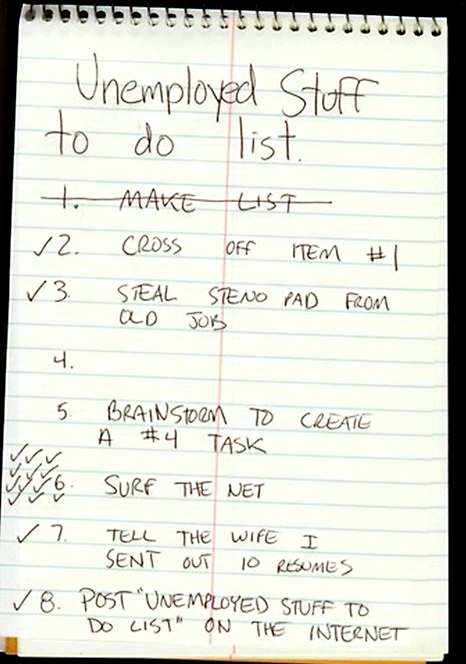
I decided to treat my getting laid off as an opportunity in disguise, a chance to explore all my options and do a little long-term career planning. At the same time, watching my old schoolmate Ali Velshi on CNN talking about the credit crunch and dealing with a worried wife meant that I should try to secure some income as quickly as I could.
I had one big thing working in my favour: nearly seven years’ worth of tech evangelism and seven years’ worth of blogging meant that I had a lot of what VC Howard Lindzon calls “social capital” in the bank. I did not have to go looking for job openings; they came looking for me. A number of people called, emailed, instant-messaged and tweeted me, asking if I’d be interested in working for their company and if I could make some time to meet them for an interview. The jobs ran the gamut from doing some development for an adult entertainment site to doing tech evangelism for some pretty high-profile companies. I did interviews with just about everyone who called me, which meant that I was actually busier as an unemployed man that I was during my last weeks at b5.
I even got a call from an editor at a very reputable book publisher in New York asking if I’d ever given any thought to writing a book. The answer, by the way, is “yes”, and as soon as an idea comes to me, I plan to fly down to Manhattan in a nice suit and do a pitch over cocktails, which if Mad Men is not lying to me, is how these things go.
Most of the companies who called were the type I’d always worked for: either startups or small operations where I’d have the ability to wear many hats, make a significant contribution and have a great degree of freedom. Medium to large companies were completely off my radar, but I’d have to say that it was mostly because I’d grown accustomed to thinking of myself as a small company man.
As a result, it seemed unreal when I got a number of calls from different people from the same organization, all asking variations on the same question:
“Have you ever considered joining The Empire?“
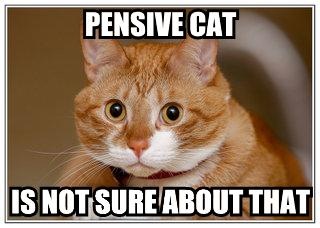
I’ll be honest: I had some qualms about joining Microsoft.
Fear of “selling out” and working for a big company wasn’t even a factor. It probably should matter at 21, but not at 41. To borrow a saying often misattributed to Churchill: if you’re not at least a little liberal at 21, you have no heart; if you’re not at least a little conservative at 41, you have no brain.
There’s also the standing order from The Missus: “No more working for fucking under-30 CEOs!”
Finally, consider the great truth expressed in the comic below:
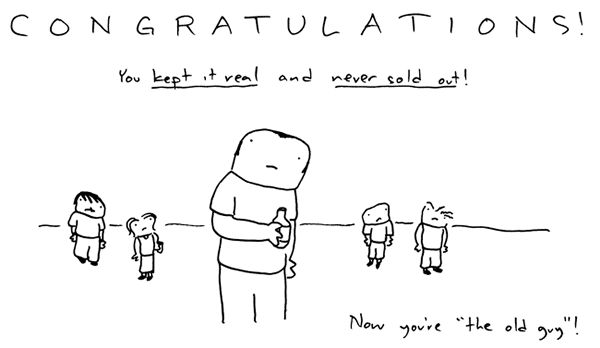
My qualms didn’t arise out of loyalty to Apple; they make some really nice machines and an excellent OS, but I’m not really one of those “It’s Apple or nothing” types. They also didn’t come from an “open source forever, Microsoft never!” feeling either. Open source has resulting in some great things happening, but once again, I’m not a “F/OSS or nothing” kind of guy, either.
My qualms came from the feeling that Microsoft had little to offer to me as a developer. Once upon a time, back when my friend Adam Smith and I had a little software development constancy, Microsoft was my friend. From the mid-1990s to the release of .NET 1.0, it felt as if they were constantly reaching out to developers. Then somewhere along the way, at around the same time as the rise of web applications, Apache, PHP and later things like Rails and Django, something happened. Microsoft had apparently switched their focus away from developers and towards the suits – the decision-makers who approved the tech purchases, rather than the people who actually had to live with the decisions. I’m sure that many developers felt the same way I did: Microsoft slowly faded from my radar because it seemed as if I’d faded from theirs.
I think that my friend Danny O’Brien expressed this best when he wrote:
One of my big bones with MS stuff is that it always makes me feel like I’m eating out of the trash bins outside a cubicle farm. All of their software is designed to help busy executives plan their lives. Everyone I know uses it to try and write birthday cards and chat with their friends. When people use Microsoft Office they use it anywhere but in an office. Microsoft knows this – but it also knows that the money comes from their corporate clients, so there’s a limit to how much it can bend its software toward a wider customer base. Ultimately when you use MS software, you’re not the end user MS perceives at all: we’re just living off the scraps Microsoft leaves out after feeding its big customers.
One thing that convinced me to join Microsoft was a small-seeming but important sense of a “sea change” at Microsoft.
Perhaps it was their hiring of some people I’d never expect: David Crow (I’ll admit that I was ready to bet some good money on his leaving within six months, saying “It’ll either end in tears…or gunfire”), Bryce Johnson, John Lam and Danah Boyd.
It might have been their willingness to even consider talking to me after my posting this graphic on my blog:

It might have been some very lengthy conversations I had with friends who worked at Microsoft.
It might have been this thing:

I won an XBox 360 at the 2006 Boston Ajax Experience conference, and I was surprised at how much I loved it. It doesn’t feel like a “Microsoft product” – it feels like something built by people who love games for people who love games. The “Less Hulk, More Bruce Lee” story behind the design of the XBox 360 that Jean-Luc David told me probably helped as well.

What probably convinced me most was the opportunity to work for a couple of great people who believed in me, Mark Relph and John Oxley. They offered the combination of a lot of support and a great deal of latitude, the ability to work largely from the home office and most importantly, the freedom to inject my own personal style into the work I’d do. I think Mark’s line, “We enter as friends, we leave as friends”, struck a chord with me.
At the end of my sixth(!) interview, John said “We’d like to take you on. Are you interested?”
I replied “To quote Homer Simpson, I have only two questions: ‘How much?’ and ‘Give it to me!’”
In the end, I was unemployed for a grand total of three weeks. Considered the economic collapse taking place all ‘round, that’s not bad at all.

At the dawn of 2009, just over a year after leaving my tech evangelist job, I have escaped from one imploding company, been laid off from a downsizing one and finally ended up at a job that fits me like a glove. After this journey, I have become…a tech evangelist.
I feel like “Fry” from Space Pilot 3000, the premiere episode of Futurama. Fry, a p[izza delivery boy in 1999, is frozen on New Year’s Eve 1999 and revived a thousand ears later. In the year 3000, a computer determines that he is best-suited to being a delivery boy, and he spends much of the episode trying to escape this fate. In the end, he cheers as he finds work with a distant relative…as a delivery boy.
Captain Kirk had a similar experience: he always returned to his first, best destiny – being captain of the Enterprise. I feel that I’ve managed to do the same, and with the added bonus of not having a court martial, blowing up the ship, losing my son and getting demoted from Admiral.
Like the young man in the “Bottle Rocket” video near the start of this essay, I took some risks and got a little singed in the process. But as Charles Follymacher also pointed out, sometimes you “manage to live to tell the tale and, wherever possible, wreak [sic] the profits,” and that’s what happened to me in the end.
As any decent poker player will tell you, winning isn’t in the cards you’re dealt, but how you play them. In spite of all the craziness this year, I did quite well.
I’m looking forward to 2009.
[This article also appears in The Adventures of Accordion Guy in the 21st Century.]
 JPG magazine was beautiful but unsustainable. A photography magazine whose contributors were also its readers, it was part publication, part online community and part art project. You didn’t have to be an established professional photographer to get published in JPG; all you had to do was submit a really good shot (and everyone’s got one really good shot in them). Photography magazines aren’t really my thing, but I actually bought a couple of issues of JPG because the photos and articles they featured caught my eye.
JPG magazine was beautiful but unsustainable. A photography magazine whose contributors were also its readers, it was part publication, part online community and part art project. You didn’t have to be an established professional photographer to get published in JPG; all you had to do was submit a really good shot (and everyone’s got one really good shot in them). Photography magazines aren’t really my thing, but I actually bought a couple of issues of JPG because the photos and articles they featured caught my eye.
With the public’s flagging interest in print media, the current economic situation and the costs of running a print publication on photo magazine-quality paper, JPG magazine was running out of money. They tried for months to find buyers or investors without success. Yesterday, they announced that they will be shutting down completely – not just the print magazine, but their website as well – on Monday, January 5th.
If you’re a JPG reader or are just interested in what the magazine was all about, you should follow their suggestions, which include:
Remember, if you want to download PDF back issues, do it before Monday!
[This article was also published in The Adventures of Accordion Guy in the 21st Century.]p>
Global Nerdy is my third tech blog.
 My first was The Happiest Geek on Earth (don’t bother looking; it’s been offline for years now). I started it back in 2002 when my non-tech readers started to doze off after reading tech articles I posted on The Adventures of Accordion Guy in the 21st Century. It took its name from an article on Boing Boing that Cory Doctorow wrote about me when he heard that I’d taken up part-time work as an accordion-playing go-go dancer at a popular downtown Toronto bar.
My first was The Happiest Geek on Earth (don’t bother looking; it’s been offline for years now). I started it back in 2002 when my non-tech readers started to doze off after reading tech articles I posted on The Adventures of Accordion Guy in the 21st Century. It took its name from an article on Boing Boing that Cory Doctorow wrote about me when he heard that I’d taken up part-time work as an accordion-playing go-go dancer at a popular downtown Toronto bar.
In September 2003, a couple of months after Tucows took me on as their tech evangelist, I started The Farm (again, no longer in operation), which was pretty much The Happiest Geek on Earth run under the Tucows banner. While I did cover stuff directly related to Tucows, there’s only so much you can blog about Tucows’ core business of domain name registration, hosted email and managed DNS. Luckily for me, they didn’t mind that I blogged about all sorts of things of interest to developer and techies, and I like to think that I helped shift the perception of Tucows being “oh yeah, the shareware company”.
In mid-2006, I was chatting with George Scriban, my old pal from Crazy Go Nuts University. Somehow we got to talking about the tech blogosphere and came to the conclusion that yes, the web needed yet another tech blog. We’d both pitch in: George would cover things from his biz-dev and product-dev point of view, while I’d blog from the developer and goofball angles. We couldn’t think up a name, so I used a little program I’d been working on – The Duke of URL – to access Tucows’ “namespinner” service to come up with available domain names given some keywords. The keyword “nerd” resulted in a lot of junk names, but one stood out: globalnerdy.com.
“Global Nerdy. That doesn’t sound bad,” I said.
“Actually, it sounds pretty good,” replied George.
“Even has a bit of an Engrish feel to it,” I added.
And now you know where the blog’s name came from.
George’s made some very valuable contributions to this blog. Those insightful entries about the tech business in the archives in 2006? Those are his. He has a much better grasp of that stuff than I ever will, and he’s an astute observer and a great writer. The reason this blog registers on Techmeme at all? That’s also George’s doing. The Economist are fools for not snapping him up. He hasn’t contributed in a while, but that’s because the demands of both Microsoft (where he’s a senior product manager) and family life (a lovely wife and two handsome sons) have kept him pretty busy. While George’s presence on this blog is missed; he seems to be always present. Since 1987, we’ve somehow managed to end up working at the same place, whether it’s writing articles for the same paper, working at the same pub, joining Cory Doctorow’s startup and now, working for The Empire.
That means that you Global Nerdy readers are stuck with me. I’d like to start by thanking you, the readers, for your continued readership, comments, support and kind words.
I’d like to extend special thanks to my hosting company, Pressharbor, for doing an excellent job – the blog’s been Dugg, Reddited, Slashdotted, Boing Boinged, Hacker Newsed and Techmemed, and not once has it shown any sign of blogging down or just giving up and 500ing. If you’re looking for some rock-solid WordPress hosting, Pressharbor are the people to see.
Here’s what StatCounter has to say about Global Nerdy’s readership since the beginning. As with all web stats packages, you have to take these numbers with a grain of salt:
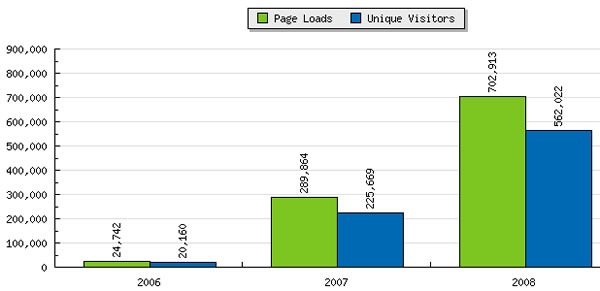
As the graph shows, 2008 was Global Nerdy’s best year, with 702,913 pageloads and 562,022 uniques, which is more than double 2007’s numbers.
Here’s how the 2008 numbers break down by quarter:
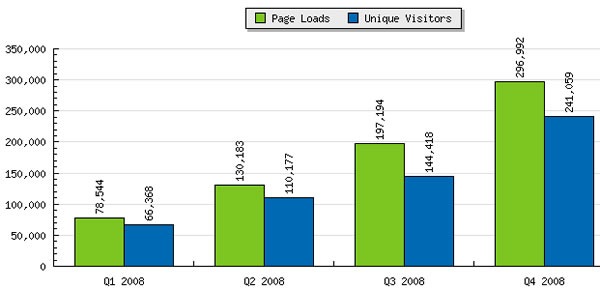
It’s a steady improvement, with Q4’s pageloads nearly four times that of Q1. A fair bit of it comes on the heels of a Stack Overflow podcast in which Jeff “Coding Horror” Atwood said some very nice things about Global Nerdy. (Thanks, Jeff, and remember: I have a Microsoft expense account now! The steak’s on me when next we meet!)
While the numbers are a good indicator of whether I’m writing stuff that readers are finding interesting, I’m really looking to improve my qualitative performance. By that, I mean write better articles and get into some interesting things, which I’ll cover very soon in a “What’s Up in 2009?” article.
Update, January 5, 2008: Captain David Faggard, Chief of Emerging Technology for the U.S. Air Force, sent me an updated version of their chart, whose changes are based on your comments. The chart appears in this article, and you can click on it to download a full-sized PDF version.
You’ve probably seen many articles on companies and organizations saying that they take social media seriously. Here’s one such organization that you might not expect: the United States Air Force. Take a look at the Air Force Blog Assessment chart, reproduced below:
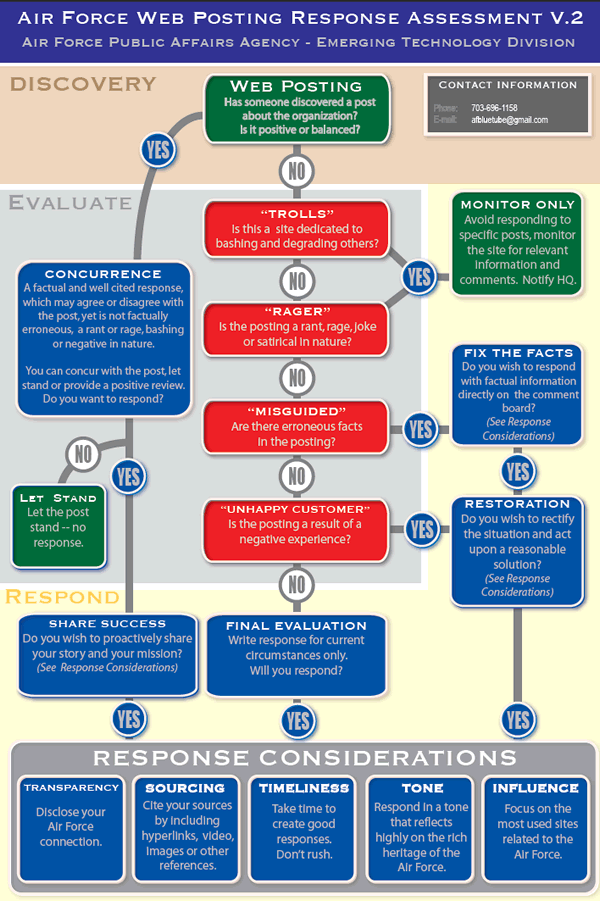
Click the diagram to download the PDF version (455K).
The “rules of engagement” are quite good. You might find them to be useful for your own blogs, whether personal or corporate.
WebInkNow recently covered the Air Force’s approach to social media, which is far more involved than many companies who only pay lip service to the idea. They’ve assigned someone the role of “Chief of Emerging Technology”, whose job is to develop strategy, policy and plans for the Air Force’s “communicators” and whose mission is to use or build web applications as a means of engaging Airmen and the general public in conversation. The goal is to make every single Airman a communicator.
The Air Force has quite a presence on the web, which includes:
As with the Blog Assessment chart, you might want to use the Air Force’s social media strategy as a model for your own. Check out WebInkNow’s article for more.
Call me easily entertained, but I still find remixes inspired by the movie 300 funny, such as Brian Jepson’s remix of the Univac ad from the previous entry:
You can click the photo above to see the remix at full size or here to see it in Brian Jepson’s Flickr collection.
Here’s a computer ad from 1956 – it’s for Univac computers, a brand name that was as synonymous with “computer” in the same way that “Xerox” was once synonymous with “photocopier”:

Click the ad to see it at full size.
Ad courtesy of Miss Fipi Lele.
Here’s the text of the ad. If it seems a little strange to your modern sensibilities, it’s because it’s ad copy from the era of Mad Men — that’s just how advertising was back then. Note that lack of technical jargon or specs, neither of which would’ve been useful back then, when very few people would’ve known what they meant:
“You’re Trying to Divide by Zero”
A scientist, testing a formula on Univac recently, was amazed to see the computing system stop, then automatically type the reproof: “You’re trying to divide by zero.” A quick check proved that Univac, as always, was right.
This graphic demonstration points out just one of the many Remington Rand refinements in the art of computer programming and operation. For Univac has been trained to spot human errors. It can now carry out commands given in simple business English. It can even manufacture its own program of instructions automatically – at electronic speeds, with unparalleled accuracy.
These skills have been developed as a direct result of Univac’s unique position in the field of electronic data-processing. Because, with every Univac delivered goes 10 years’ experience in electronic computing…5 years’ experience in the commercial type of data-processing. This wealth of background in programming and operation is unobtainable elsewhere.
The unprecedented savings of Univac data-processing have been proved by solving actual consumer problems – not by working out theoretical solutions with non-existent computers. You can be sure that, when you install the Univac, you’ll get under way faster, surer and more economically because the System has already handled similar work.
Univac is now at work in leading organizations throughout the country. And, in today’s competitive market, the company which cuts its overhead first comes out on top. So don’t wait until 1957…1958…or 1959 to cash in on the tremendous savings available to you now with the Remington Rand Univac System.
Some observations:
[Update: Looks like I got my programming language timelines wrong. “mistercow” points out on Reddit that COBOL didn’t appear until 1959 and suggests that the “commands in simple business English” language is probably FLOW-MATIC, one of COBOL’s predecessors.]
And finally, two things that a programmer in today’s economy should keep in mind. It’s almost as if they’re special messages sent through time:
Although these statements were made back when computers were rare and extremely expensive and well before there was a computer on every office desk – in fact, well before computers could even fit on desks – they hold true today. If you’re a programmer looking to make a living in 2009, it’ll pay to develop applications that solve actual problems and either help people make money or save it. To borrow a line from Don Dodge at Startup Empire, make sure your applications are aspirin (must-haves), not vitamins (nice-to-haves)!